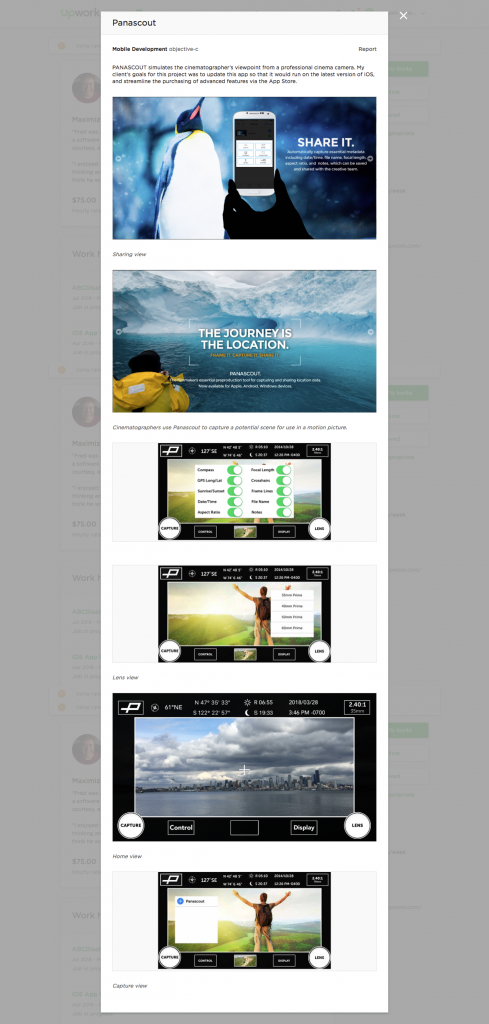4 Ways To Create a More Successful Freelancer Portfolio

Every part of your Upwork profile matters, but some sections are typically more important. Your title and overview, for example, play a strategic role when it comes to capturing the attention of potential clients. Also playing a critical role? Your portfolio.
The benefits of a solid portfolio can include higher profile views and better-quality job invites from potential clients as well as increased confidence in your abilities and professionalism even if you’re relatively new to the Upwork site.
While some talents may be more visual than others, your portfolio matters whatever your particular area of expertise: It’s your opportunity to show clients what you can do through projects you’ve worked on. If you’re changing niches, you can also use your portfolio to highlight expertise that may not stand out from the “Employment history” or “Other experiences” sections.
Here are four tips that can help you leverage your portfolio, regardless of your skill set.
1. Tell a story for each service you provide
If you have more than one area of expertise, your portfolio should reflect your range of skills.
For example, let’s say you’re a copywriter who loves to work on product descriptions, but you’re also a pro writing blog posts and website copy. To show potential clients how multi-talented you are, upload three to five portfolio items that show your latest product copywriting, blogging, and website copywriting projects. Each one will be categorized separately with its own unique project description.

When it comes to organizing your portfolio items, put your best work front and center into the first four tiles. Remember: Focus on projects that are the most relevant to the type of projects you’re currently trying to win.
2. Leverage your portfolio creatively
Aim to make your portfolio exciting, not just a copy of your “Employment history” information. By thinking of each piece as its own story—whether you use words, images, reports, or something else to do so—you’re more likely to get people to pay attention to the projects you want to share with them. Here are a few different ways to approach each example:
- Case studies: Write a short story about a challenge you have solved or a business you have helped.
- Snippets: Include excerpts of your work—you don’t need to use the entire project, especially if it’s large or complex. For example, you could include a summary of a longer document, or share a preview or clip of a larger piece of work.
- Screenshots: Take screenshots of your work, such as spreadsheets, research documents, apps, social media posts, or even anonymized Google Analytics campaign results.
- Results: Create a visual representation of your successes using diagrams, charts or graphs.
- Testimonials: Have former colleagues or clients vouch for your skills by including a testimonial. Make sure to make any quotes or testimonials you’re using visually appealing.
- Samples of your own work: Portfolio samples do not necessarily need to be a piece of paid work you have done. Consider creating a small number of relevant work samples, especially if you aren’t able to showcase previous projects.
Sometimes you can’t use your past work in your portfolio: Maybe you don’t have permission to show the project, or the nature of your work is confidential. If this is the situation you find yourself in, you can focus on other sections of your profile and the proposal to showcase your experience and skills and look for ways to maximize the impact of your testimonials.
3. Provide additional information for each portfolio item
When you’re ready to add items to your portfolio, provide as much information about each piece as possible by painting a clear picture of your role in each project. This can include selecting a relevant work category and subcategory, as well as tagging the portfolio item with applicable skill tags.
Use the project description text box to write a brief but interesting story about how the project came to be. For example:
- Explain what your main task or deliverable was
- Describe how you tackled the client’s problem
- Highlight the skills, tools, and technologies you used to fulfill the client’s requirements
- Include any other important details about how you nailed the project goals.
Keep your write-up short and concise; one or two short paragraphs should do the trick!
You can also link the items in your portfolio with past projects. This draws clearer connections between projects, portfolio pieces, client feedback, and client ratings, which can help verify your expertise, build credibility for prospective clients, and give these items more visibility on your profile.

4. Update your portfolio regularly to reflect your skills
Chances are you have old projects in your portfolio that you’ve outgrown already. As you hone and improve your skills, you don’t want prospective clients to see obsolete projects that don’t truly reflect how good you’ve become.
Your best bet is to either revamp old project descriptions to call out the skills and expertise that are currently more in demand, or to delete them all together. If you feel that these projects are still relevant, refresh your presentation to make your portfolio items look shiny and new again. Otherwise, remove these projects from your portfolio to make room for new ones.
Pro Tip: Don’t let your portfolio slide. Every project you bring to the table comes with a hefty side dish of experience and growth—both of which will help make you a more valuable professional in the market. This improvement is what you want your clients to see, so don’t hesitate to push excellent work each and every time. As soon as a client gives permission to use the finished project in your portfolio, upload the screenshot, paste the link, and point it out to the next client to come your way.
Want to learn more about how to improve your profile?
This article is part of a series written to provide tips for your freelancer profile on Upwork. Check out:
Heading







%20(1).png)
Get This Article as a PDF
For easy printing, reading, and sharing.


.svg)
%201.svg)








.png)
.png)
.png)
.png)
.png)




















.png)



.svg)


-min.png)



.png)





